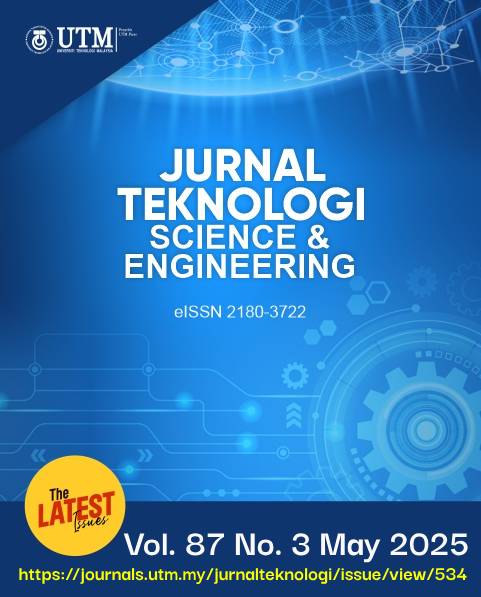APPLICATION OF THE NTU-18 TURBIDITY DEVICE FOR REAL-TIME RIVER SEDIMENTATION MONITORING
DOI:
https://doi.org/10.11113/jurnalteknologi.v87.22118Keywords:
Suspended sediment, sediment estimator, NTU-18, sediment distribution, rouseAbstract
The NTU-18 turbidity sensor tool is used for sediment measurement so that the process can be done more easily and practically. The purpose of this study is to analyze and calculate the distribution of sediment using the Reuse equation based on the measurement results with the NTU-18 turbidity sensor tool at a certain point in the Way Khilau watershed. The method used is the Reuse equation. Measurement data is used to calculate particle fall velocity and Reuse parameters. Sediment concentration was calculated with the depth of the reference surface increased by 0.05 m until it approached the depth of the riverbed. The sediment distribution ratio is calculated at each depth and the result is a graph of the relationship between the sediment distribution ratio and the average concentration value at the reference surface depth. Then the amount of sediment in the Way Khilau watershed can be approximated by the equation y = 502,58 X2 – 1017,4 X + 514,85 to y = 604,12 X2 – 1228,8 X + 624,81. The sediment distribution graph shows that sediments in the Way Khilau watershed tend to be bed load. This occurs because of the relatively low flow velocity in the Way Khilau watershed. The conclusion is that the amount of sedimentation in the Way Khilau watershed can be estimated using the Reuse equation, although only with certain point data and can be calculated the amount of sediment at all river depths.
Keywords: Suspended Sediment, Sediment Estimator, NTU-18, Sediment Distribution, Reuse
References
Kironoto, B. A. 2007. Kajian Lokasi Pengambilan Sampel Sedimen Suspensi Arah Transversal Terhadap Nilai Konsentrasi Sedimen Suspensi Rata-Rata Tampang (Perbandingan Data Pengukuran Laboratorium dan Lapangan). Din. Tek. Sipil. 7(2): 101–108.
Doi: https://publikasiilmiah.ums.ac.id/bitstream/handle/11
/116/3_%20-Kironoto-2.pdf?sequence=1.
Andayono, T., & Yustisia, H. 2015. Pengaruh Angkutan Sedimen Dasar Terhadap Perhitungan Debit Sedimen Suspensi dan Lokasi Pengambilan Sampelnya. Rekayasa Sipil. 12(2).
Doi: https://media.neliti.com/media/publications/127332-ID-pengaruh-angkutan-sedimen-dasar-terhadap.pdf.
Muharis. 2017. Konsentrasi Sedimen Suspensi Rata-Rata Kedalaman Pada Saluran Menikung Berdasarkan Hasil Pengukuran Dan Analisis. J. Tenik Pengair. 008(01): 139–145.
Doi: 10.21776/ub.jtp.2017.008.01.14
Suif, Z., Ahmad, N., Othman, M., Jelani, J., & Yoshimura, C. 2022. A Distributed Model of Hydrological and Sediment Transport in The UPNM Catchment. Jurnal Teknologi. 84(2): 163–170.
Doi: https://doi.org/10.11113/jurnalteknologi.v84.17482.
Wiryamanta, D. R., & Dermawan, V. 2021. Kajian Distribusi Konsentrasi Sedimen Suspensi Menggunakan TSS Meter pada Sungai Brantas di Desa Pendem Kota Batu. Jurnal Teknologi Dan Rekayasa Sumber Daya Air. 1(2): 379–392.
Doi: https://jtresda.ub.ac.id/.
Gomez, B., and M. Church. 1989. An Assessment of Bedload Sediment Transport Formulae for Gravel Bed Rivers. Water Resour. Res. 25: 1161–1186.
Hermawan, A., Afiato, E. N., & Ardian, O. H. 2023. Konsentrasi Sedimen Suspensi Rata-Rata Kedalaman Berdasarkan Pengukuran 1, 2, dan 3 Titik Pada Aliran Dipercepat. JUSTER: Jurnal Sains Dan Terapan. 2(2): 2809–7750.
Doi: https://jurnal.jomparnd.com/index.php/js/article/vie
w/742.
Almedeij, J. H. 2002. Bedload Transport in Gravel Bed- Stream Under a Wide Range of Shields Stress. Dissertation. Virginia Polytechnic Institute and State University, Blacksburg, Virginia.
Dwipayana, A. R., Bakhtiar. AB., Kusdian, D. 2020. Pengaruh Akumulasi Sedimen pada Saluran Irigasi Terhadap Prioritas Rehabilitasi Konstruksi (Studi Kasus D.I. Leuwi Kuya Kab. Bandung & Kab. Bandung Barat). Jurnal Techno-Socio Ekonomika. 14(1): 30–45.
Doi: https://vdocuments.mx/pengaruh-akumulasi-sedime n-pada-.html?page=1.
Andawayanti, U. 2019. Pengelolaan Daerah Aliran Sungai (DAS) Terintegrasi. Malang: Universitas Brawijaya Press.
Kironoto, B. A. 2007. Pengaruh Angkutan Sedimen Dasar (Bed Load) Terhadap Distribusi Kecepatan Gesek Arah Transversal pada Aliran Seragam Saluran Terbuka. Forum Tek. Sipil. XVII(2): 556–579.
Doi: https://ojs.petra.ac.id/ojsnew/index.php/cef/article/ view/17360.
Kelley, C. D., Krolick, A., Brunner, L., Burklund, A., Kahn, D., Ball, W. P. and Weber-Shirk, M. 2014. An Affordable Open-source Turbidimeter. Sensors. 14(4): 7142–7155.
Doi: https://www.mdpi.com/1424-8220/14/4/7142.
Ariadi, M. M., Sugriwan, I. dan Fahrudin, A. E. 2018. Sistem Alat Ukur Kekeruhan Berbasis Mikrokontroler ATMega16A-PU. Jurnal Fisika Flux: Jurnal Ilmiah Fisika FMIPA. 1(1): 112–119.
Doi: https://ppjp.ulm.ac.id/journal/index.php/f/article/vie w/6154/5031.
Mulyana, Y. and Hakim, D. L. 2018. Prototype of Water Turbidity Monitoring System. IOP Conference Series: Materials Science and Engineering. 384(1).
Doi: https://iopscience.iop.org/article/10.1088/1757-899X/ 384/1/012052.
Romdania, Y., Banuwa, I. S., Yuwono, S. B., Wahono, E. P., & Triyono, S. 2023. Designing The Technology for Turbidity Sensor-based Automatic River Sedimentation Measurement. Jurnal Teknologi. 85(5): 13–19.
Doi: https://doi.org/10.11113/jurnalteknologi.v85.19618.
Noor, A., Supriyanto, A. dan Rhomadhona, H. 2019. Aplikasi Pendeteksi Kualitas Air Menggunakan Turbidity Sensor Dan Arduino Berbasis Web Mobile. J. Coreit. 5(1).
Doi: https://ejournal.uin-suska.ac.id/index.php/coreit/artic le/view/7945.
Azmeri. 2020. Erosi, Sedimentasi dan Pengolahannya (1st ed., Vol. 1). Syiah Kuala University Press.
Graf, W. H. 1971. Hydraulics of Sediment Transport. McGraw - Hill Book Co.
Yang, C. T. 2006. Erosion and Sedimentation Manual, Chapter 3: Noncohesive Sediment Transport, Biro of Reclamation’s Sedimentation and River Hydraulics Group, Denver, Colorado.
Chien, N. and Wan, Z. 1999. Mechanics of Sediment Transport. American Society of Civil Engineers, Reston, Va.
Giarto, R. B. 2016. Distribusi Konsentrasi Sedimen Suspensi Pada Sungai Alami (Studi Kasus Sungai Opak dan Sungai Kuning Yogyakarta). Thesis. Program Studi Teknik Sipil - Universitas Gadjah Mada, Yogyakarta.
Mubarak, M. 2016. Model Transpor Sedimen dan Limbah Domestik di Estuari. Riau: Universitas Riau.
Maulana, M. A., Aryani Soemitro, R. A., Mukunoki, T., & Anwar, N. 2018. Suspended Sediment Concentration Assessment as a Precursor to River Channel Shifting in the Bengawan Solo River, Indonesia. Jurnal Teknologi. 80(5).
Doi: https://doi.org/10.11113/jt.v80.11318.
Rouse, H. 1937. Modern Conceptions of the Mechanics of Fluid Turbulence. Transactions of the American Geophysical Union. 18(4): 605–621.
Doi: https://ascelibrary.org/doi/10.1061/TACEAT.0004872.
Romdania, Y., and Herison, A. 2024. The Effect of Steep Slopes on the Application of the Usle, Rusle, and Musle Methods. ASEAN Engineering Journal. 14(1): 229–236. https://doi.org/10.11113/aej.v14.20567.
Romdania, Y., and Herison, A. 2024. Estimation of Length and Slope Factor (Ls) as Erosion Prediction in Way Pubian Sub Watershed. ASEAN Engineering Journal. 14(3): 107–113. https://doi.org/10.11113/aej.v14.21188.
Downloads
Published
Issue
Section
License
Copyright of articles that appear in Jurnal Teknologi belongs exclusively to Penerbit Universiti Teknologi Malaysia (Penerbit UTM Press). This copyright covers the rights to reproduce the article, including reprints, electronic reproductions, or any other reproductions of similar nature.
















